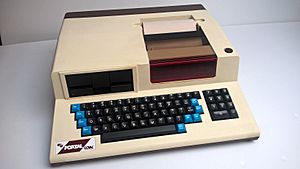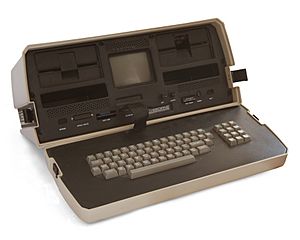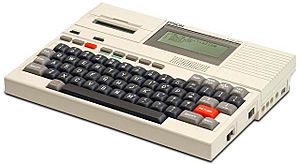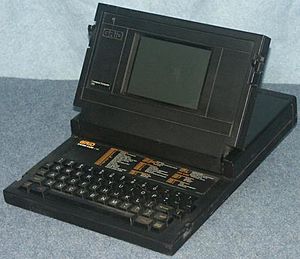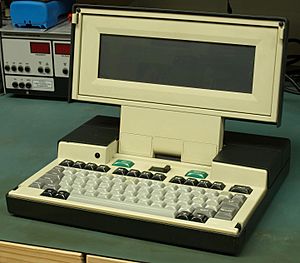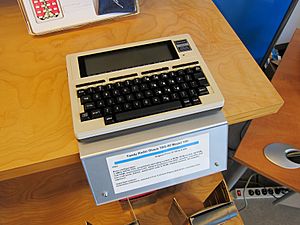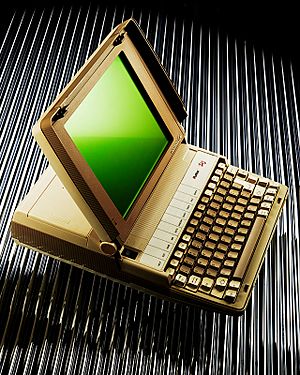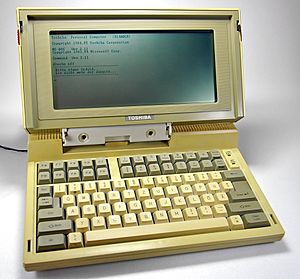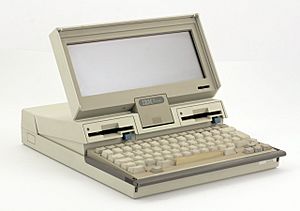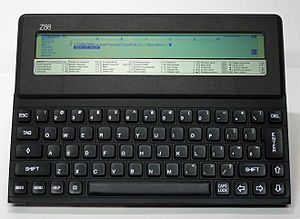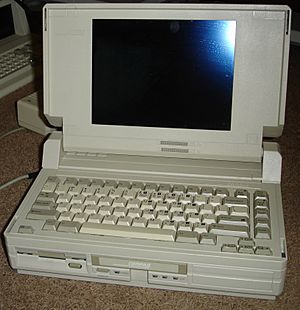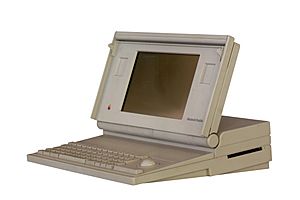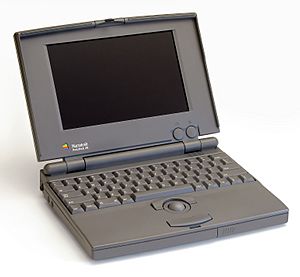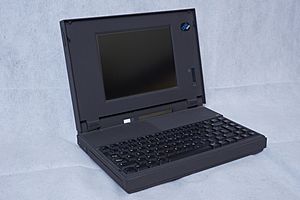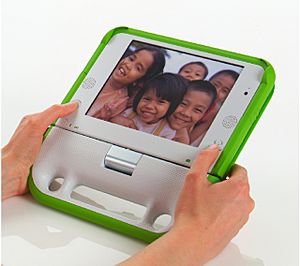History of laptops facts for kids
The history of laptops is all about how people tried to build small, portable computers starting in the 1970s. These early machines aimed to pack all the power of a regular desktop computer into a much smaller size. Imagine carrying your computer with you – that's what these inventors wanted to achieve!
Contents
- Early Portable Computers: The "Luggables"
- Epson HX-20: A Step Forward (1981)
- Grid Compass: The Clamshell Design (1982)
- Dulmont Magnum: Truly Portable Power (1982)
- Sharp PC-5000 and Gavilan SC (1983)
- Kyotronic 85 / Tandy Model 100 (1983)
- Data General/One (1984)
- Bondwell 2 (1985)
- Kaypro 2000 (1985)
- Toshiba T1100, T1000, and T1200 (1985-1987)
- IBM PC Convertible (1986)
- ZDS Supersport (1987)
- Hewlett-Packard Vectra Portable CS (1987)
- Cambridge Z88 (1988)
- Compaq SLT/286 (1988)
- NEC UltraLite: The First Notebook (1988)
- Apple and IBM: New Designs
- Improved Technology: Laptops Get Better
- Netbooks: Small and Affordable (2007)
- Smartbooks: Phone Meets Laptop (2009)
- Images for kids
Early Portable Computers: The "Luggables"
Before true laptops, there were "portable" computers that were quite big and heavy. People often called them "luggables" because you had to lug them around!
The Portal R2E CCMC (1980)
One of the very first portable computers was the "Portal" from a French company called R2E Micral CCMC. It came out in September 1980. This machine had an Intel 8085 processor and 64 kilobytes of RAM. It featured a small 32-character screen, a keyboard, a floppy disk drive, and even a small printer! It weighed about 12 kilograms (26 pounds), which is like carrying a heavy bowling ball.
The Osborne 1 (1981)
Many historians consider the Osborne 1, released in 1981, to be the first real mobile computer. It had a tiny 5-inch screen and two floppy disk drives. It also came with a lot of software already installed. The Osborne 1 was about the size of a portable sewing machine and weighed around 11 kilograms (24 pounds). It cost about $1,795 back then. Even though it was heavy, it was revolutionary because professionals could finally take their computer and data with them.
The Compaq Portable (1982)
The Compaq Portable was the first portable computer that could run programs made for the IBM PC. It was released in March 1983 and cost about $2,995. Like the Osborne 1, it folded up into a case similar to a portable sewing machine. Later versions, like the Compaq Portable II, had better graphics. This computer helped make Compaq a big name in the computer world.
Epson HX-20: A Step Forward (1981)
The Epson HX-20, announced in 1981 and sold from July 1982, was an important step towards modern laptops. It had a full keyboard, rechargeable batteries, and a small screen that could show 4 lines of text. It also had a tiny built-in printer! While its screen and memory were very limited, it showed that small, battery-powered computers were possible.
Grid Compass: The Clamshell Design (1982)
The Grid Compass, made in 1982, introduced the "clamshell" design that most laptops use today. This is where the flat screen folds down to cover the keyboard. It had a special screen and 384 kilobytes of memory. It was very expensive, costing between $8,000 and $10,000. Because of its high price, it was mostly used by the U.S. military and NASA on the Space Shuttle. The Grid Compass needed to be plugged into power because it didn't have an internal battery.
Dulmont Magnum: Truly Portable Power (1982)
The Dulmont Magnum, designed in Australia in 1982, was one of the first true battery-powered laptops. It had a screen that showed 8 lines of text and folded down over the keyboard. This computer could be taken anywhere and offered good computing power. It ran on the MS-DOS operating system and could save information even when turned off, thanks to its battery-backed memory. It weighed about 4.8 kilograms (10.5 pounds).
Sharp PC-5000 and Gavilan SC (1983)
Two other early laptops were the Sharp PC-5000 and the Gavilan SC. The Gavilan SC, released in 1984, was the first computer to be officially called a "laptop." It had a built-in floppy disk drive and a new touchpad-like pointing device above the keyboard. Both the Gavilan and the Sharp used the clamshell design and had LCD screens.
Kyotronic 85 / Tandy Model 100 (1983)
The Kyotronic 85, launched in 1983, became one of the best-selling early laptops. It was sold by companies like Tandy (as the TRS-80 Model 100), Olivetti, and NEC. These machines ran on regular AA batteries. They had built-in programs like a text editor and a communication program, partly written by Bill Gates himself! It wasn't a clamshell, but had a screen that tilted up. It weighed less than 2 kilograms (4.4 pounds) and was very popular with journalists because it was portable, reliable, and had good battery life.
Data General/One (1984)
The Data General/One (DG-1), introduced in 1984, was truly portable, not just "luggable." It weighed 9 pounds and ran on batteries. It had two 3.5-inch floppy disk drives, a full keyboard, and a black-and-white LCD screen that could show 80 characters across and 25 lines down.
Bondwell 2 (1985)
The Bondwell 2, released in 1985, was one of the few laptops to use the CP/M operating system. It had a 3.5-inch floppy disk drive built-in, which was unusual for CP/M laptops. Its screen had a resolution of 640x200 pixels. The Bondwell 2 also came with popular software like WordStar and cost $995.
Kaypro 2000 (1985)
The Kaypro 2000, introduced in 1985, might have been the first commercial IBM-compatible laptop. It looked very similar to modern laptops with its brushed aluminum clamshell case. It had a screen that showed 25 lines of 80 characters, a keyboard that could be detached, and a pop-up 3.5-inch floppy drive.
Toshiba T1100, T1000, and T1200 (1985-1987)
Toshiba launched the T1100 in 1985, calling it "the world's first mass-market laptop computer." It didn't have a hard drive and ran only from floppy disks. It used a special Intel 80C88 processor that used less power. In 1987, Toshiba released the T1000 and T1200. These models were small and light enough to carry in a backpack and could run on batteries. They also introduced the "resume" feature, allowing you to pause your work and pick it up later without restarting the computer.
IBM PC Convertible (1986)
The IBM PC Convertible, introduced in 1986, was another early IBM-compatible laptop. It had a color-compatible LCD screen and two 3.5-inch floppy drives. It weighed about 13 pounds (5.9 kilograms).
ZDS Supersport (1987)
The ZDS Supersport series became very successful thanks to a large order from the U.S. Air Force in 1987. This contract led to the purchase of over 200,000 laptops! The Supersport had an Intel 8086 processor, two floppy drives, a screen that lit up, and a battery pack. Later models had a faster processor and a 20 MB hard drive. This deal made ZDS the biggest laptop supplier in 1987 and 1988.
Hewlett-Packard Vectra Portable CS (1987)
In 1987, HP released a portable version of their Vectra CS computer. It had the classic clamshell design, but it was still very heavy and large. It featured a full-size keyboard and a big amber LCD screen. It was one of the first computers to use a 1.44 MB 3.5-inch disk drive.
Cambridge Z88 (1988)
The Cambridge Z88, designed by Clive Sinclair and introduced in 1988, was another notable computer. It was about the size of a sheet of paper and ran on standard batteries. It had basic programs for spreadsheets, word processing, and communication. It showed how portable computers could become even smaller.
Compaq SLT/286 (1988)
By the late 1980s, laptops were becoming popular with business people. The COMPAQ SLT/286, released in October 1988, was the first battery-powered laptop with an internal hard disk drive and a high-quality VGA compatible LCD screen. It weighed about 14 pounds (6.4 kilograms).
NEC UltraLite: The First Notebook (1988)
The NEC UltraLite, released in October 1988, was perhaps the first "notebook" computer. It weighed only 2 kilograms (4.4 pounds) because it didn't have a floppy or hard drive. It was much smaller than earlier portable computers and could be carried like a notebook, with its screen folding over like a book cover.
Apple and IBM: New Designs
Apple Macintosh Portable (1989)
Apple's first laptop was the Macintosh Portable, released in September 1989. It weighed 7.2 kilograms (16 pounds) and was powered by a lead-acid battery. This laptop was important because it was one of the first to include a built-in pointing device, called a trackball.
IBM PS/2 Note and CL57SX (1992)
The IBM PS/2 note was IBM's first laptop with a clamshell design. The 1992 CL57sx model was IBM's first commercial laptop with a color screen. These models introduced features like the PS/2 port for connecting devices and an early version of a docking station.
Apple PowerBook (1991)
The Apple PowerBook series, launched in October 1991, brought in many design changes that are now standard on laptops. This included space for a palm rest in front of the keyboard. Later PowerBooks added color screens (1993), the first true touchpad (1994), and built-in Ethernet for networking (1994).
IBM ThinkPad (1992)
Introduced in 1992, the IBM ThinkPad 700C set a new standard for business laptops. It had a clamshell design similar to the PS/2 line, but with a unique red TrackPoint pointing device. ThinkPads became known for their modular design, durability, and features like removable drive bays and secondary batteries. Some later models even had a built-in camera (1994).
Improved Technology: Laptops Get Better
In the early days, laptop screens were hard to see. PC Magazine in 1986 even joked about them, saying they looked like "elongated smudges." But as technology improved in the 1990s, laptops became much more useful and popular, and their prices dropped. Several key improvements made this possible:
- Better Batteries: Heavy lead-acid batteries were replaced with lighter and more efficient ones, like nickel-cadmium, nickel-metal hydride, and then lithium-ion batteries.
- Power-Saving Processors: Computer chips were designed to use less power, which helped laptops last longer on battery. The Intel 386SL processor, for example, was made specifically for laptops.
- Better Screens: Early laptop screens were black and white or grayscale and often blurry. Then came color screens, first STN, then much better TFT LCD technology. These new screens were larger, sharper, and could show colors accurately, making them a good replacement for traditional desktop monitors.
- Improved Storage: Early laptops only had floppy disk drives. Then, thin and reliable hard disk drives became available, allowing users to store much more information. Smaller 2.5-inch hard drives were developed specifically for laptops. Some new laptops even use Flash RAM, which has no moving parts.
- Better Connectivity: Built-in modems and standard ports made it easier to work away from home. The addition of network adapters, USB (from 1997), and Wi-Fi (from 1999) made laptops as easy to connect to other devices as desktop computers. Many newer laptops also have built-in wireless internet.
- Other Cool Features: Some laptops now include built-in video cameras for video calls and fingerprint sensors to keep your data safe.
Netbooks: Small and Affordable (2007)
In 2007, Asus introduced the Eee PC 701. It was a small, lightweight laptop with a 7-inch screen and a low price. Even though there were earlier attempts at small computers, the Eee PC was a big success because it was so affordable, small, and versatile. Intel later gave these types of computers the name "Netbook." Other companies like Acer, MSI, and Dell soon made their own similar devices.
Smartbooks: Phone Meets Laptop (2009)
In 2009, Qualcomm introduced the term "smartbook." This describes a new type of device that combines features from both a smartphone and a laptop.
Images for kids


